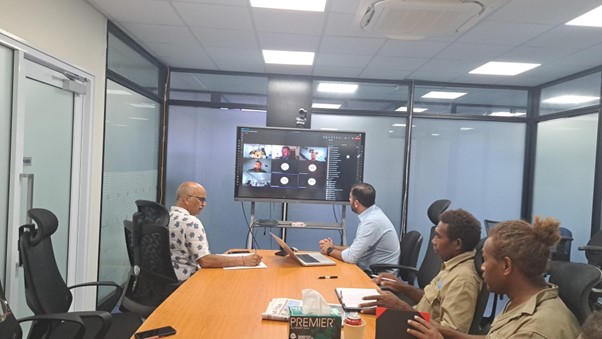"Guadalcanal's rivers are a vital ecological and cultural resource. Protecting them today means securing sustainable development for the future."
Resources Department from the Ministry of Mines, Energy and Rural Electrification, and the Ministry of Provincial Government and Institutional Strengthening.
Chaired by Dr David Annandale, the session underscored the importance of integrating sustainable river management practices to mitigate the ecological impacts of hydropower dams and other developments affecting river basins, such as mining and agriculture.
Participants engaged in discussions on strategic environmental planning, focusing on long-term conservation, policy development, and scientific advancements in river ecosystem assessments. A key highlight was an in-depth review of the Strategic Environmental and Social Assessment (SESA), which commenced in February 2024. This process involved extensive fieldwork and analysis of major rivers across Guadalcanal, including the collection of 282 environmental DNA (eDNA) samples from 48 sites. The findings revealed significant ecological variations: northern rivers such as Mataniko, Tina, Lungga, and Ngalimbiu exhibited higher anthropogenic stress, whereas the Weather coast Rivers demonstrated superior biodiversity and ecological health, highlighting the need for targeted conservation efforts.
"eDNA is a rapid and effective biodiversity assessment tool, especially in inaccessible terrains like the Upper Tina Catchment," said Dr David Annandale.
"This workshop showcased the first large-scale application of eDNA analysis in the Solomon Islands and the Pacific, with 282 samples collected from 48 sites."
One of the key discussions centred on recommendations for the proposed Water Resources Act. This new legislation aims to integrate critical water resource protection measures, including environmental flow guidelines, buffer zones, and groundwater protection thresholds. These measures are essential to ensuring the sustainability of river ecosystems and preventing long-term environmental degradation, particularly in the context of hydropower development.
SESA findings indicated that downstream areas near settlements suffer from high turbidity and pollution, significantly impacting biodiversity and the ecosystem services that support local communities.
"The i-Tina Basin has been identified as a high-priority conservation area."
Participants also addressed threats posed by invasive species and habitat degradation, emphasizing the need for ongoing conservation and monitoring initiatives. A key takeaway from the session was the introduction of eDNA as an innovative tool for conducting rapid biodiversity assessments. Unlike traditional surveys, which can take six to ten months, eDNA offers a faster, cost-effective alternative, particularly in challenging and remote terrains like the Upper Tina Catchment.
Community engagement was highlighted as a crucial component of sustainable river management. Discussions explored the potential establishment of a conservation fund to support local initiatives aimed at protecting river ecosystems. Moving forward, further research initiatives are planned, including additional data collection on river ecology, the preparation of a scientific paper comparing river systems, and continued eDNA sampling to monitor biodiversity across the region.
In his closing remarks, Dr Annandale expressed gratitude for the participants' contributions and emphasized the need for ongoing engagement, research, and conservation efforts. The Project Office reaffirmed its commitment to sustainable hydropower development, ensuring that conservation and ecological health remain top priorities.
The session marked a significant milestone in promoting sustainable river management in the Solomon Islands, strengthening efforts to balance hydropower development with long-term environmental conservation.
The proposed Water Resources Act is set to replace the outdated River Waters Act of 1964, ushering in a new era of sustainable water resource management for the Solomon Islands.

Caption: Project Manager Mr. Pradip Verma and E&S Manager Mr. Sahibzada leading the team in this online training
For more information, contact:
Communications Officer: Jeanine Gadepeta email: jeanine.gadepeta@tina-hydro.com
Tina Hydropower development project
+677 25133
About Tina River Hydro Development Project (TRHDP)
The first large scale renewable energy project for the Solomon Islands delivering benefits such as more affordable electricity and improved accessibility to cleaner, more reliable energy sources for communities now and in the future. It is being implemented by the Solomon Island Government with financing and support from the Abu Dhabi Fund for Development, the Asian Development Bank, the Government of Australia, the Green Climate Fund, Korea EX-IM Economic Development Cooperation Fund, and the World Bank.
Find out more on www.tina-hydro.com
A National Project of Solomon Islands | Tina River Hydropower Tina River Hydropower is a National Project of Solomon Islands and has as its objective to provide more affordable and reliable energy options to Honiara. www.tina-hydro.com |
or follow us on Facebook, LinkedIn, and YouTube
